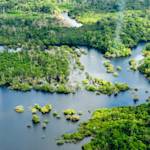Tijuca Forest established as National Park
1961 • Brazil
Between the seventeenth and nineteenth centuries, the Tijuca Forest was the site of widespread devastation due to sugarcane and coffee agriculture. Degradation of the forest caused a major water supply crisis in the city of Rio de Janeiro in the early 1860s, which led Emperor Dom Pedro II to demand that degraded areas be replanted. Careful replanting efforts, together with gradual regeneration restored Tijuca Forest, which was declared a national park in 1961. Today, it is entirely surrounded by Rio de Janeiro, the second most populous city in Brazil, making it the world's largest urban forest. It is a precious example of the now-rare Atlantic Forest biome, and is home to 67 threatened plant species, including eleven species that occur nowhere else. Rainfall is notably higher in the park than in other areas of the city, while temperatures are notably cooler.
José Drummond, "The Garden in the Machine: An Environmental History of Brazil's Tijuca Forest", Environmental History 1, No. 1 (Jan., 1996), 83-104. Additional source: Nina Pougy, “Urban Forests and the Conservation of Threatened Plant Species: The Case of the Tijuca national Park, Brazil,” Natureza & Conservação 12.2 (2014): 170-73.
Image: Clarice Braúna Mendes, CC BY-SA 4.0 via Wikimedia Commons


Learn about Maya Lin’s fifth and final memorial: a multi-platform science based artwork that presents an ecological history of our world - past, present, and future.

Discover ecological histories and stories of former abundance, loss, and recovery on the map of memory.

Learn how we can reduce our emissions and protect and restore species and habitats – around the world.

See how art can help us rethink the problems we face, and give us hope that each one of us can make a difference.

Help make a global memorial something personal and close to home. Share your stories of the natural world.


